Selecting and Arranging Objects
Select Objects
In order to edit an object or its part, you should select it. Then you can use tools or panels to modify the object's properties, such as the shape, color, size and others. The program lets you select an object, an object's part or multiple objects using different methods.
If an object is locked, it cannot be selected directly on the canvas.
Select a Single Object
To select an object, activate the Move tool ![]() , and then click on the object.
, and then click on the object.
As a rule, you should click on a visible part of an object to select it. For example, when a rectangle has a stroke but there is no fill, you should click on the stroke. Clicking inside the rectangle won't select it. On the other hand, if the Fill option is on, you can click anywhere on the rectangle.
Select Multiple Objects
To select several objects, activate the Move tool ![]() , and then click on each of the objects holding down the Shift key.
, and then click on each of the objects holding down the Shift key.
Another way to select multiple objects is to outline those objects with the selection frame. Click with the Move tool at an empty point and drag the tool. The selection frame will appear between the starting point and the current position of the tool. Make the selection frame big enough to completely or partially outline the objects you want to select.
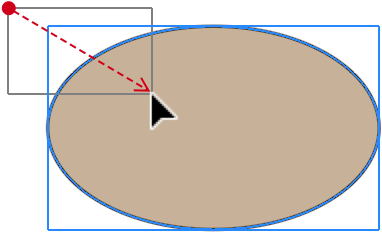
To deselect one of several selected objects keeping the rest of them selected, Shift-click on that object.
To deselect all selected objects, and select all unselected objects, choose Select > Invert Selection (Cmd-Opt-Shift-A).
Select All Objects
To select all objects that are not locked, use either Select > Select All (Cmd-A) or Select > Select All on Active Sheet (Cmd-Opt-A) command from the main menu.
Select an Object in the Layers Panel
You can select an object by clicking on its name in the Layers panel.
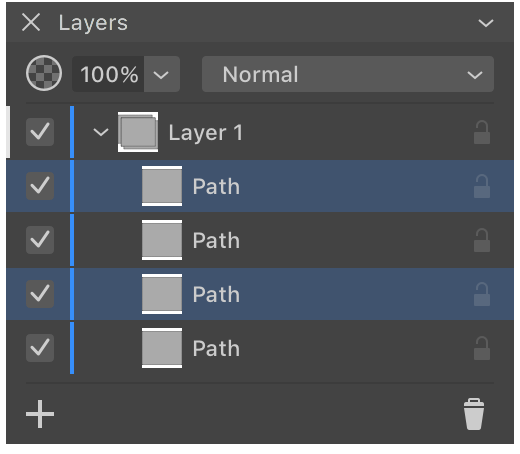
To select multiple objects, click on their names in the Layers panel holding down the Cmd key.
To select multiple objects, the names of which follow one after another, click on the first name, then press and hold the Shift key and click on the last name.
Select Objects with Identical Properties
You can select objects that have the same property or a set of properties in the Appearance panel. This may be useful when a design contains many similar objects (e.g., snowflakes or flowers on a postcard). You could create one, make it look as you wish and then make its copies. Once you decide to change their color, you have to select all of them. In such cases, the Select > Select Same menu comes in handy.
To select all objects with identical properties:
- Select one object that will be used as a model to search for others.
- Open the Select > Select Same menu and choose one of the options.
The following selection commands are supported:
- Select > Select Same > Appearance selects objects with exactly the same properties in the same order in the Appearance panel.
- Select > Select Same > Fill & Stroke selects objects with all the same Fill and Stroke properties placed in the same order. Effects such as shadow are ignored.
- Select > Select Same > Fill Color selects objects whose upper Fill properties have the same color. Stroke properties (including their location in the list in relation to Fill) as well as effects are ignored. The transparency of the color is also taken into account.
- Select > Select Same > Stroke Color selects objects whose upper Stroke properties have the same color. Fill properties (including their location in the list in relation to Stroke) as well as effects are ignored. Notice that stroke width (whether it is constant or variable) doesn't matter. So, both objects will be selected if one has a black Stroke and the other has a black Brush property. The transparency of the color is also taken into account.
- Select > Select Same > Stroke Width selects objects whose upper Stroke properties have the same width. Fill properties (including their location in the list in relation to Stroke) as well as effects are ignored. Notice that Stroke and Brush with the same width are treated as identical. Strokes with variable width (e.g, created with the Path Width tool) are ignored.
Be cautious with this selection tool. It might select more objects than you expect. Try to make sure visually that there are no objects that you didn't want to select.
Deselect an Object
To deselect one or multiple objects, click with the Move tool ![]() at any empty space on a sheet or on the canvas.
at any empty space on a sheet or on the canvas.
An alternative way is to choose Select > Deselect All (Cmd-Shift-A) from the main menu.
Isolation Mode
The Isolation mode is used to work with a particular object or its part. In this mode, only the isolated object can be edited. The rest of the objects are locked and displayed in dimmed colors. As soon as you deactivate the Isolation mode, those objects will become unlocked.
You can isolate a standalone object, an object that is a part of a compound object or group.
To isolate an object, double-click on it with the Move or Selection tool. If an object is in a group that itself is a part of another group, click on the object several times until you reach it.
An alternative way to enter the Isolation mode is to select the layer that you want to edit in the Layers panel. Then bring up the context menu and choose Isolate Active Layer.
To exit the Isolation mode, hit the Esc key, or click the "X" button in a bar below the horizontal ruler, or double-click outside the isolated object. This bar displays the name of the isolated object. If the isolated object is inside a group, the name of the group will be indicated there.

In the Isolation mode, the Layers panel hides the list of layers and objects and shows the "Isolation Mode" item as the top level object. The isolated object will be one of its subitems directly, or it can be inside of one of nested subitems.
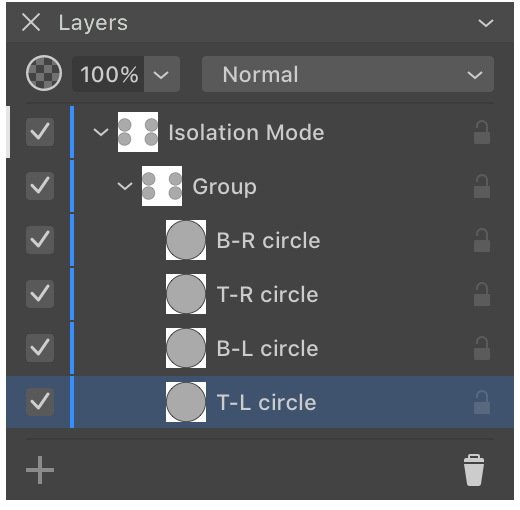
Select Objects Inside a Group
It is possible to access an object inside a group without ungrouping it. There are several ways to do this. One of them is to use the Isolation Mode discussed earlier.
Another way is to make use of the Layers panel. You should click on a triangle near the name of the group to expand it and show the grouped objects. Then click on the name of the object you want to select.
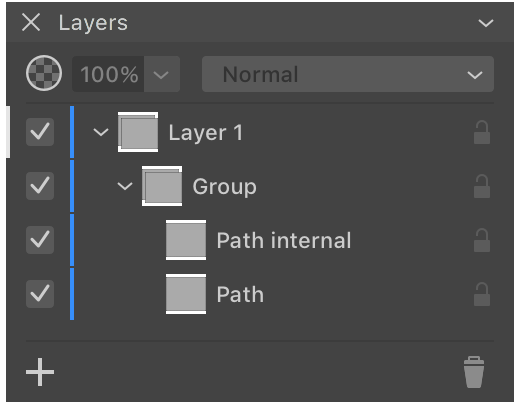
Finally, it is possible to select an object in a group by clicking on it with the Selection tool. Neither the entire group nor other objects in it won't become selected.
Locking and Unlocking Objects
Locking an object helps you prevent it from being moved or edited accidentally.
To lock an object, use one of these methods:
- Select the object and choose the Layer > Lock (Cmd-L) command from the main menu.
- Click on the object's Lock icon in the Layers panel.
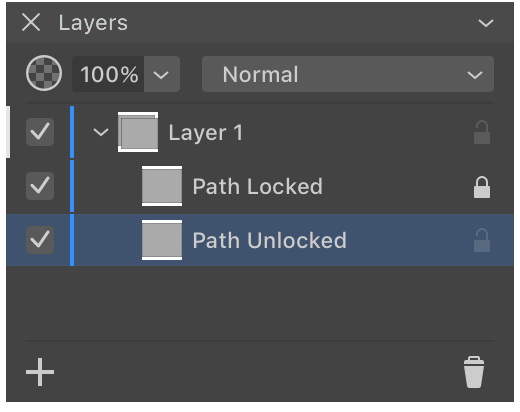
To unlock an object, click on its Lock icon in the Layers panel.
To unlock all objects, select Layer > Unlock All (Cmd-Opt-L).
Defining the Order of Objects
A currently selected object can define where an object that you add to the design should appear in the stack of objects. This concerns different types of objects that you can add: paths, texts, graphics from the built-in libraries, pasted and imported objects. When the Draw/insert above the selection option in the Preferences is activated, a new object will be placed right above the selected object. When the option is deactivated or none of the objects is selected, a new object will appear at the upper position in the active layer. The overall order of layers and objects can be changed using the Layers panel.